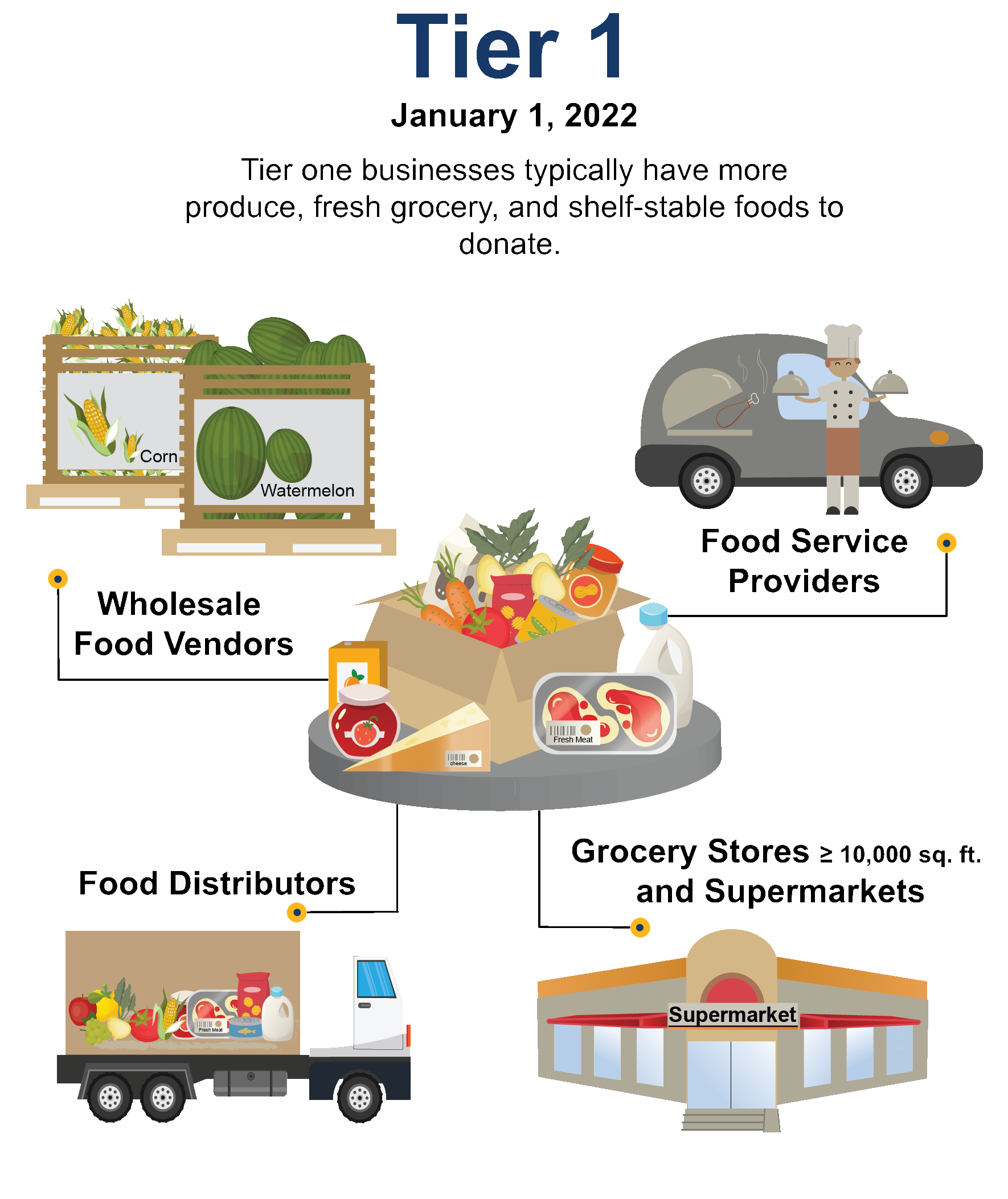Food Recovery and Donation Rules

California State law SB 1383 aims to keep food and other compostable materials out of landfills to reduce emissions that contribute to climate change. An important requirement of the new law is that food generating businesses must recover edible food that would otherwise be disposed and donate it to feed people.
Learn more about all the requirements of the law at www.StopWaste.org/rules.
Are you a food recovery organization or service provider? Click here to learn more.
Rules for food generating businesses, institutions, and schools
Much of the food currently thrown away in California is perfectly good to eat and could feed people instead of going to waste. Surplus edible food includes food not sold because of appearance, age, freshness, grade, or surplus. Setting up systems to make this high-quality food available for people to eat will cut greenhouse gas emissions, and help alleviate food insecurity in our communities.
|
Type of entity |
Deadline for compliance |
|---|---|
| Tier 1: Large supermarkets, grocery stores, food service providers, food distributors, and wholesale food vendors. To learn which businesses are Tier 1, click here. | January 1, 2022 |
| Tier 2: Large health facilities, hotels, venues, event spaces, restaurants, state agency facilities, & schools with an on-site food facility. To learn which businesses are Tier 2, click here. | January 1, 2024 |
By the dates listed in the table above, these entities must:
- Recover the maximum amount possible of surplus edible food generated
- Partner with one or more food recovery organizations or services to pick up or receive surplus edible food
- Have a written contract or agreement with the food recovery organization(s) or service(s)
- Safely recover edible food in accordance with the California Retail Food Code
- Track and maintain records of food recovered each month including type, frequency of collection and amounts in pounds
- Allow the Enforcement Agency to review records upon request
Resources for setting up a surplus edible food recovery program
- Food donation guide for businesses
- Food donation guide for schools
- Food recovery notice
- List of food recovery organizations and services in Alameda County
- More information on requirements and resources for food recovery organizations and services
- Customizable food recovery service agreement/contract
- Link to State food recovery resources
Request help
Our knowledgeable field team provides free phone, email, virtual, and in-person support to help set up a system to recover and donate surplus edible food.
Commercial edible food generators
SB 1383 requires certain food generators to donate the maximum amount of surplus edible food generated to food recovery organizations. The law phases food donors in under two tiers to give businesses and jurisdictions more time to expand or build new food recovery infrastructure and capacity.
 Tier 1 food generators
Tier 1 food generators
Deadline for compliance: January 1, 2022
- Supermarkets: A full-line, self-service retail store with gross annual sales of two million dollars ($2,000,000), or more, and which sells a line of dry grocery, canned goods, or nonfood items and some perishable items.
- Grocery Stores: Grocery store with a total facility size equal to or greater than 10,000 square feet.
- Food Service Providers: An entity primarily engaged in providing food services to institutional, governmental, commercial, or industrial locations of others based on contractual arrangements with these types of organizations.
- Food Distributors: A company that distributes food to entities including, but not limited to, supermarkets and grocery stores.
- Wholesale Food Vendors: A business or establishment engaged in the merchant wholesale distribution of food, where food (including fruits and vegetables) is received, shipped, stored, and prepared for distribution to a retailer, warehouse, distributor, or other destination.
Tier 2 food generators
 Deadline for compliance: January 1, 2024
Deadline for compliance: January 1, 2024
- Restaurants: Restaurant with 250 or more seats, or a total facility size equal to or greater than 5,000 square feet.
- Hotels: Hotel with an on-site food facility and 200 or more rooms.
- Health Facilities: Health facility with an on-site food facility and 100 or more beds.
- Large Venues: Large venue means a permanent venue facility that annually seats or serves an average of more than 2,000 individuals within the grounds of the facility per day of operation.
- Large Events: Large events means an event, including, but not limited to, a sporting event, a flea market or a festival, that charges an admission price, or is operated by a local agency, and serves an average of more than 2,000 individuals per day of operation of the event, at a location that includes, but is not limited to, a public, nonprofit, or privately owned park, parking lot, golf course, street system, or other open space when being used for an event.
- State Agencies: A state agency with a cafeteria with 250 or more seats or a total cafeteria facility size equal to or greater than 5,000 square feet.
- Local Education Agencies: A local education agency with an on-site food facility. Local education agency means a school district, charter school, or county office of education that is not subject to the control of city or county regulations.
To file a complaint for a violation of this law, click here.